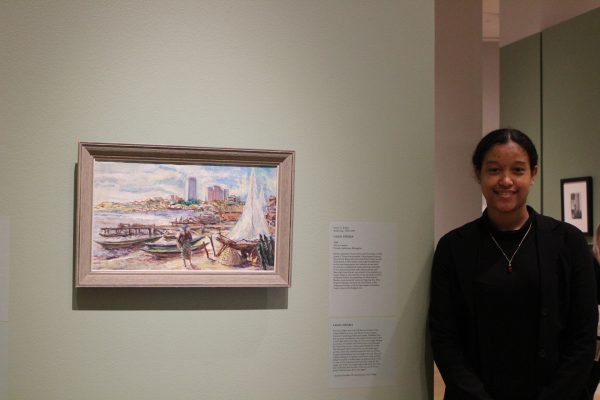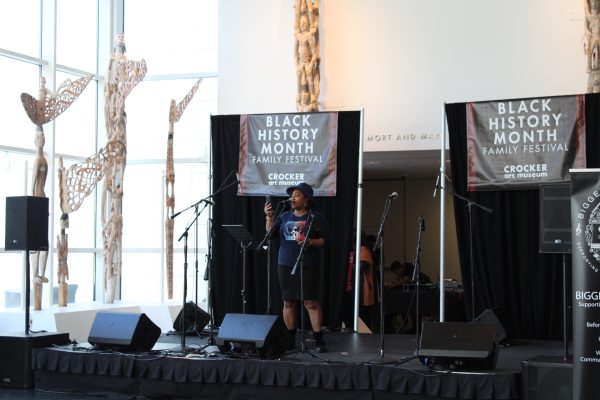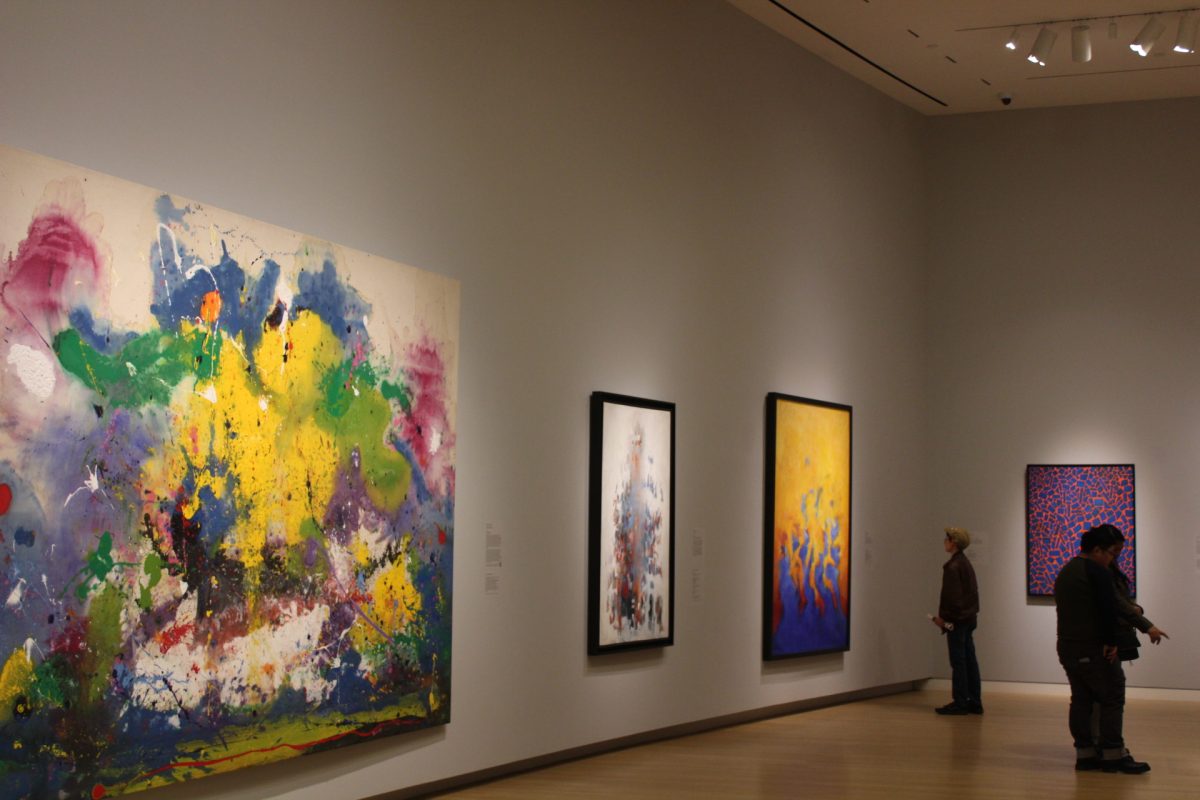Echoing sounds of upbeat bass, a dwindling saxophone and rhythm-based music played as guests entered the Black History Month Family Festival at the Sacramento Crocker Art Museum to view the exhibits “Black Artists in America: Civil Rights to the Bicentennial” and “Joyce J. Scott: Messages” on Sunday.
Art capturing the power and voice behind Black American culture covered the walls of the three-floor museum, with varied painting techniques such as abstract, cubism and acrylic to convey themes of racial identity, communication with Black audiences and the struggle for equality.
As guests entered the “Black Artists in America: Civil Rights to the Bicentennial” exhibit pieces such as “Openness,” “Amos and Andy” and “The Four Figures” were first to be seen, as their vibrant colors and abstract design were quick to catch the eye.
One featured artist, Alma Thomas, used her art to express the troubles and tribulations of Black Americans by connecting her work to the natural world. Her 1971 artwork “Etude In Color,” is a piece hung near the entrance, possessing intricate brush strokes and acrylic paint appearing like lipstick strokes on a canvas.
“She used all the primary and secondary colors and the color white to accent the colors, to create movement within the painting,” Crocker Art Museum family program guide Barbara Haig said. “She used, as her primary inspiration, the way the leaves look when the wind blows, and you can see the sunlight through them.”
Along with each painting was a small poem written by students, who used their literary knowledge to capture and convey the historical importance of each piece.
Sacramento City College student and writer Juanita Gonzales’ poem was posted beneath an artwork that resonated with her, called “Lagos Nigeria“ drawn by James A. Porter in 1964.

“I was born in California and I’ve been to the coast multiple times on field trips,” Gonzales said. “This painting really connected with me personally because being on the water is visceral and it makes me feel small, but also not insignificant. It just sets things really into perspective.”
Students from all over Sacramento were chosen to have their words displayed by historical paintings to help convey a modern resonation to the pieces they discussed. Children from as young as 7-years-old had the pleasure of seeing their poems shared.
Another student who had her poem on display was 16-year-old Elk Grove High School student Kyle Hayes. She wrote her poem on the piece “Amos and Andy” created by Jeff Donaldson in 1972.
“The painting is all about defiance, becoming heroes and facing discrimination,” Hayes said. “In my poem I focused on their faces, their struggles, but also how they rose up and overcame those struggles and became heroes to not just themselves but the African community.”
The paintings on display were all taken from the three-part series organized by Dixon Gallery and Gardens in Memphis, Tennessee, that displays the evolution and change of African American art, in the 1950s, 60s and 70s.
The exhibit features over 60 pieces created and made by 48 talented and historical artists.
Next door to the “Black Artists in America: Civil Rights to the Bicentennial” exhibit, sat the second exhibit “Joyce J. Scott: Messages,” which discusses subjects of political and racial themes of discrimination.
Every piece on display is created by Joyce J. Scott, known for her imaginative artwork, with intricate and beaded designs that speak to her overall theme of political injustice in Black American history.
In her exhibit are glowing designs of beads placed together to create compositions of intricate and one-of-a-kind pieces, such as her more notable artworks “Mz. Teapot” and “Teal.”
The materials most commonly associated with her designs are teapot glass beads, plastic beads, thread, wire, armature and peyote stitch that bring her work to life.
Outside the exhibit and within the doors of the museum, the first Crocker Art Museum’s Black History Month Festival took place. An all-day event where music, art, poetry and guest speakers were honored.
Black men and women of all talents shared their passion among the glowing Friedman court, a long black stage was built for performances to be shared on.

As the afternoon dwindled, poet Naimah Moon took the stage to share a poem that she wrote to honor Black History, called “A Conversation With My Ancestors.”
Moon said she wanted to create a piece that not only spoke to the struggles of Black History but also conveyed the art of poetry in her piece. Her poem expresses change, beauty, hardships and struggles in the beautiful medium of words.
“I think poetry is such a dynamic art,” Moon said. “It can capture words and in those words, you can see the imagery and when putting that all together, it’s just phenomenal to see how influential it can all be.”
RELATED: ‘The True Black History Museum’: Instilling knowledge, awareness and pride
Every year the Crocker Art Museum curates an exhibit to honor the history of Black Americans, but branching out of that regularity and making a celebration of the event was something everyone appreciated.
Trudy Allyson Taliaferro, an attendee of the event and one of the first Black women broadcasters on KCRA 3, said that an event of this nature is an important step toward honoring the history of Black Americans and helps give recognition to names that contribute to Black culture outside of politics.
Taliaferro said she was happy to see the progress being made and the crowd of people who came together to see the artwork and the inspirational speakers.
The “Black Artists in America: Civil Rights to the Bicentennial” exhibit will remain open till May 19, while the “Joyce J. Scott: Messages” exhibit will close on June 23.



































































































































DC • Feb 22, 2024 at 4:28 pm
Thank you for sharing.
It was really almost like being there.
A very well, put together article